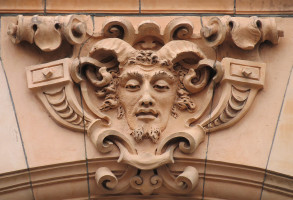
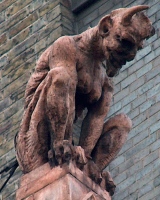
Satyrs are a fairly widespread subject in architectural sculpture. The satyr is associated with paganism, and Classical architecture, which hearkens back to 2,500 years ago, is an appropriate setting for the satyr. We can have a satyr as a sort of demonic or monstrous creature, as in gargoyle form – but most often, the satyr is used as a symbol of pagan pleasure – a light-hearted joy of the moment such as music, dance or the drinking of wine. For this reason satyr sculpture is often associated with theatres and music halls, taverns, and other places of pursuit of pleasure such as shopping arcades, or anything to do with the high life. Here are some examples of Victorian and Edwardian satyr sculpture, in an architectural setting, and, as the genre became rather popular around the fin de siecle, a rather high proportion of works in terra cotta.
Variations in satyr sculpture.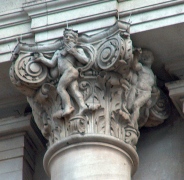

The characteristics of an ancient Greek satyr are a broad, sometimes grotesque face, large pointed ears, a beard, a muscular, typically nude body with a short horsy tail behind. Over time, our idea of satyrs has broadened out to generally incorporate a pair of horns. The beard remains in place, usually, and the mouth of our satyr typically is at least partly open.
Sometimes we see half figures of satyrs – classical herms, associated in Classical times with fertility, but in the Victorian context more likely to represent abundance or plentifulness. Such a half figure may be used in place of a pillar, thus an Atlantes. The Atlantes to the right below has with him a nice crouched, full figure with cloven hooves – a faun – for contrast, as well as a central roundel with a satyr's head in profile.
The most common satyr sculptures are where just a head is used as architectural sculpture, where the only attributes will generally be the beard and horns. But this is not quite true, as our satyrs generally have older than youthful faces, and even if not distorting their faces, have wrinkles and lines indicative of previous facial exertions. The examples below include a wise, elderly satyr, a Bacchanalian one with open mouth, and no horns, and a cunning looking satyr profile who perhaps indicates sinful pleasure rather than innocent.
A fair proportion of satyr heads are found as keystone heads to arches (a separate page on keystone heads in general is on this page, and lots of specifically bearded keystone heads are on this page), and examples are below, two with horns, two without. These are all demonstrations of the sculptor's art when allowed to indulge in some fantasy. They show a good range of satyric expressions, ears, eyes and horns, and the two on the right have forked beards .The one on the far right has two pipes.
We end with a a few variations on the theme. The sculpture below left is of a hornless satyr-type with tongue stuck out - you will need to click on the picture to enlarge to appreciate his full pulchritude (another tongue-sticker is on this page), then a bestial horned face like an anthropomorphic goat, definitely at the demonic rather than innocent pagan pleasure end of the spectrum. Third along is a rather classical satyr's head, with a very broad face, and tightly curled horns. Finally, to the right, a winged half figure satyr acting as a supporting bracket.
Other satyr sculpture variations.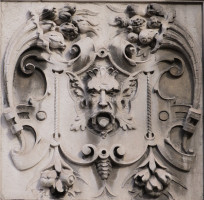
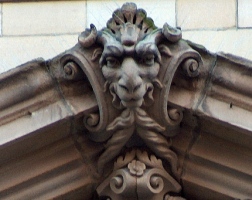
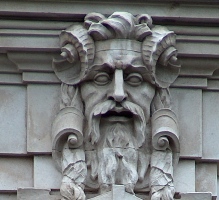
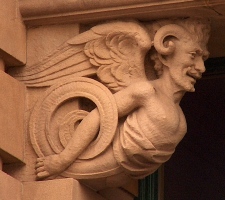
Visits to this page from 13 Mar 2014: 12,783
Sculpture pages // Merman sculpture // Angel Statues // Goat sculpture